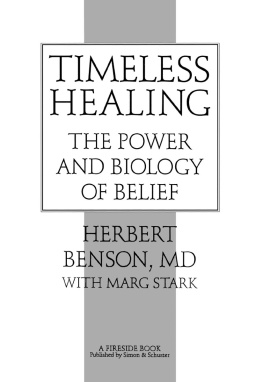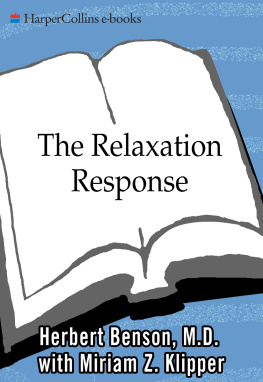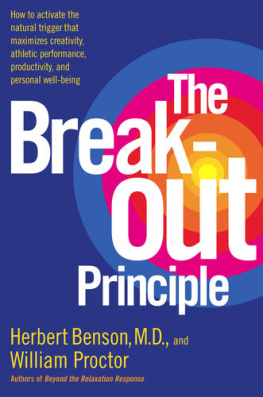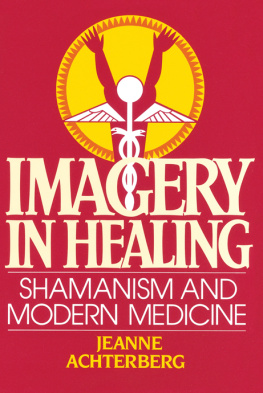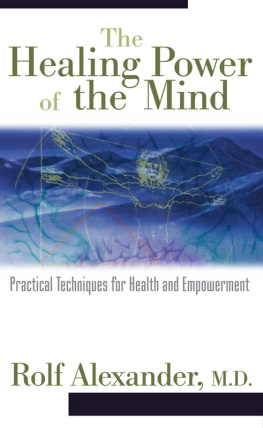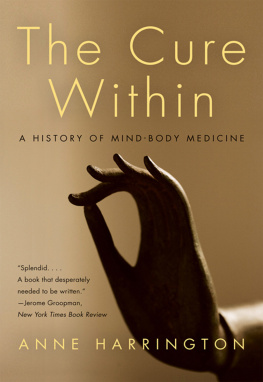
ALSO BY HERBERT BENSON, MD
The Relaxation Response
(with Miriam Klipper)
The Mind/Body Effect
Beyond the Relaxation Response
(with William Proctor)
Your Maximum Mind
(with William Proctor)
The Breakout Principle
(with William Proctor)
ALSO BY HERBERT BENSON, MD,
AND EILEEN M. STEWART, RN, C, MS
The Wellness Book
(with the Staff of the Mind/Body Medical Institute)
ALSO BY MARG STARK
A Different Tongue
(a drama about faith and AIDS)

FIRESIDE
Rockefeller Center
1230 Avenue of the Americas
New York, NY 10020
Copyright 1996 by Herbert Benson, MD
All rights reserved, including the right of reproduction in whole or in part in any form.
F IRESIDE and colophon are trademarks of Simon & Schuster Inc.
Library of Congress Cataloging-in-Publication Data
Benson, Herbert [date].
Timeless healing: the power and biology of belief / by Herbert Benson, with Marg
Stark.1st Fireside ed.
p. cm.
Originally published: New York: Scribner, 1996
Includes biographical references.
1. Mental healing. 2. Theraputics, Suggestive. I. Stark, Marg. II Title.
RZ400.B45 1997
615.852dc21 9649270 CIP
ISBN-13: 978-1-4391-7575-0
ISBN-10: 1-4391-7575-6
See backmatter for text permissions.
Visit us on the Web:
http://www.SimonandSchuster.com
To life!
ACKNOWLEDGMENTS
I gratefully acknowledge my colleagues at the Mind/Body Medical Institute, the Deaconess Hospital, and the Harvard Medical School, without whose many contributions to the field of mind/body medicine this work would not have been possible. Whenever I could, I have tried to mention their names in the text.
Over my thirty years at Harvard Medical School, many different institutions, corporations, and foundations have supported my research and teaching activities with their financial contributions. My thanks to all of them for enabling me to present the theories of this book. Current funding sources for Mind/Body Medical Institute projects include: The California Wellness Foundation; The John Templeton Foundation; Sam Wyly Fund of the Communities Foundation of Texas, Inc.; Charles J. Wyly Fund of the Communities Foundation of Texas, Inc.; Castle Rock Foundation; William K. Coors; David B. Kriser; State Street Foundation; Amelior Foundation; Lewis N. Madeira; The Charles Englehard Foundation; Laurance S. Rockefeller; The Masco Foundation; and The Harold Grin-spoon Charitable Foundation. The Trustees of the Mind/Body Medical Institute have been an unstinting reservoir of support whose friendship, time, talent, and financial contributions have ensured the growth and successful future of the Institute.
For her expertise in helping with the books references, I am most grateful to Patricia Zuttermeister. For his wise counsel, I wish to thank my attorney, Robert E. Cowden III. I also thank Arrco Medical Art and Design, Inc., for their fine artwork.
This work evolved with the expert creative advice of my literary agent, Patti Breitman. I wish to thank her for her insight, which graced the project from start to finish. I am grateful also to publisher Susan Moldow for her commitment to the work and for her editorial contributions.
I was so impressed with Marg Stark when she interviewed me for a magazine article on unconventional medicine that I asked her to be my collaborator on this book. Our subsequent friendship has been a joy. Her writing skills and original contributions have made my choice inspired.
On her behalf, Marg Stark has asked me to acknowledge Dennis Hawk for his legal counsel. She also wishes to thank her parents, Bill and Joyce, for living their beliefs, and her husband, Darwin, for believing in her.
The individual contributions of patients are often lost in the conclusions of scientific data. Ultimately though, individuals who agreed to participate in studies made the research findings of this book possible. I am grateful to them, as I am to my patients who shared their stories in this book.
Finally, I am forever grateful to my wife, Marilyn, for her unending support and advice.
CONTENTS
FOREWORD
In my previous books, I have focused on the things that individuals can do to heal themselves. As I tracked modes of self-care, trying to isolate benefits and reduce these therapies to their purest forms, a much larger principle emerged. I became impressed with the human trait to turn to beliefs and faith in times of illness and need, and so I spent more than thirty years developing the findings I present in this book. Practicing medicine and conducting medical research, Ive learned that invoking beliefs is not only emotionally and spiritually soothing but vitally important to physical health.
I have had the privilege of observing belief-inspired healing in many of my patients. But to enable them to speak freely about their experiences with remembered wellness and the faith factor, I asked my collaborator Marg Stark to interview them and to recount their histories. I also ensured confidentiality by changing their names even though virtually all of them granted permission to use their true names.
I have also chosen to fully reference the scientific documentations of the book. So at the end you will find an extensive list of the scientific articles and books published on these subjects. It is my hope that this kind of evidence will form a platform upon which my scientific colleagues will further build. Perhaps then remembered wellness and the faith factor will be better recognized and implemented in medical practice.
This book is written to help people help themselves. Should you choose to apply these teachings to your medical therapy, do so in partnership with a physician to take full advantage of the solutions and cures conventional medicine has to offer.
The biology of belief ensures that it is ever present in medicine and health of all kinds whether or not its effects are acknowledged. Timelessly influential, our values and life experiences cannot help but manifest themselves. My hope is that this book will help you appreciate the power of your beliefs so you can embrace life, and the meaning of your life, for the fullest measure of health.
H ERBERT B ENSON , MD
Boston, Massachusetts
CHAPTER 1
A SEARCH FOR SOMETHING THAT LASTS
W hen I was a student at Harvard Medical School, I was taught that the greater part of what I was learning about the human body would be obsolete within five years. In other words, a few years after I finished medical school, before I even completed my hospital residency and became a full-fledged member of the medical profession, medical science would have progressed so far as to create a whole new set of rules for taking care of patients.
Thus began my search for something in medicine that lasts. I wanted to identify some timeless source of healing, the merits of which could never be denied. Not only would this treatment of choice outlast the five-year mark but it would have proven value for generations present, for generations past, and for generations to come.
I will confess that, in part, youthful laziness launched my search. No medical student relishes the idea of having to learn a subject over and over again. But my contemplation of the enduring aspects of human life began in earnest when I was twenty-one, a premed student in college, and had to face the death of my father from rheumatic heart disease. In my mind, science never adequately explained his passing. With their diagrams, definitions, and anatomic drawings, my textbooks couldnt begin to capture the spirit and presence he embodied.

